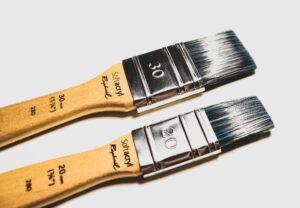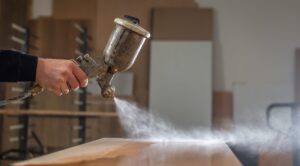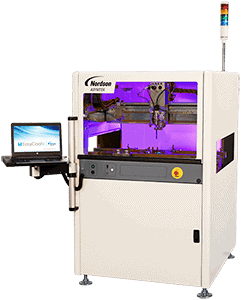
This application guide describes the equipment and processes recommended for applying MG Chemicals conformal coating products. It is the user’s responsibility to determine the chemical, mechanical and thermal compatibility of substrates prior to using any of the suggested methods. Not sure what kind of conformal coating to use? Check out this article about how to choose the best conformal coating for your specific project.
How to use Conformal Coatings?
All of our conformal coatings can be applied by paint brush, manual spray gun, dipping, and selective conformal coating machines. Several products are also available in aerosol format for ease and convenience. For large to moderate scale production runs, selective coating equipment and manual spray guns provide superior coating surfaces. The paint brush method can be used for repairs or for small scale applications, but usually will not achieve the same level of consistency and film aesthetic as spray methods. Similarly, dipping is an ideal method for low-volume projects as it is simple, yet achieves high-precision results.
The application of a conformal coating requires several subsequent processes to achieve an aesthetic finish with proper coverage.
Substrate Preparation
Most coating defects result from the presence of moisture, grease, oil, dirt, flux, and other board contaminants. Therefore, it is highly recommended that the user ensures the cleanliness and dryness of a surface prior to coating it.
- Wipe the surface with a clean cloth, wash with soap and water, then rinse and dry.
- Put on disposable gloves and clean the surface with MG’s 824 Isopropyl Alcohol or any other degreasing solvent.
- Let the surface dry completely. Elevated temperatures can accelerate drying.
Highly resistant plastics and non-plastics may require mechanical sanding or primers to enhance adhesion. After sanding and etching, clean the surface by following the previously listed steps. Mask areas that should not be coated by using MG’s 862 Solder Mask or painter’s tape. Unintended coating can be removed using MG’s 8309 or 8310A Conformal Coating Strippers.
Dilution
For most brush applications, dilution is not required. However, when applying certain coatings either by manual or automated conformal coating machines, we recommend thinning to improve film coverage and precision. The choice of thinner will depend on the selected coating and the application method (manual or automated).
If an automated spray method is used, both the platform and individual valves must be taken into account. Refer to Table 1 for suggested starting dilution ratios.
Dilution Ratio
| Brush | Dipping | Manual Spray | PVA 650 | Nordson SL 940E |
|||
| FCS300-ES | FC100-CF | SC280 N | SC350 | ||||
| 419C | None | None | None | N/A | N/A | N/A | N/A |
| 419D | None | None | 1:1 (4352) | 3:2 (4352) | 2:1 (4352) | 8:3 (4352) | N/A |
| 419E | None | None | 1:1 (4352) | 1:1 (4352) | 1:1 (4352) | 4:1 (4352) | N/A |
| 422B | None | None | 1:1 (435) | N/A | N/A | None | N/A |
| 422C | None | None | None | N/A | N/A | None | N/A |
| 4223F | None | None | 1:1 (4352) | 2:1 (4354) | 2:1 (435) | 5:1 (4352) | N/A |
| 4225 | None | None | None | N/A | N/A | N/A | N/A |
| 4200UV | None | None | None | None | N/A | N/A | None |
| Table 1: Suggested dilution ratios of MG Conformal Coatings to MG Thinners by application methods. Recommended MG Thinners are shown in brackets | |||||||
Brush on Conformal Coating

- Load the brush by dipping it into the coating (one-third of the bristle length).
- Tap both sides of the brush lightly against the side of the can. This prevents drips and runs.
- Brush the coating onto the board using long, smooth strokes. This reduces air bubbles, helps create an even coat, and minimizes brush marks.
- Reload the brush as soon as the coating flow begins to break.
- Keep subsequent brush strokes in the same direction; work strokes back into the edges of previously applied, still-wet coating, but do not recoat wet areas.
- Wait at least 3 minutes, then apply a second coat. Keep the brush from curing by dipping it in thinner and drying it before reloading.
- Apply additional coats until the desired thickness is achieved.
Manual Spray Guns

Dilute paint as recommended in Table 1 (above). Use a standard fluid nozzle gun to spray the diluted paint. The recommended settings are listed in Table 2 (below). However, performances will vary between brands.
| LVMP | HVLP | |
| Inlet pressure (psi) | 20–40 | 20–40 |
| Air flow (SCFM) | 10–15 | 10–15 |
| Air cap (psi) | 8–10 | 8–10 |
| Nozzle tip diameter (mm) | 0.8–1 | 0.8–1 |
| Table 2: Recommended manual spray guns setting | ||
Selective Conformal Coating Machines
 For higher volume applications, coatings can be applied using selected spray equipment. MG Chemicals has worked with companies such as PVA and Nordson Asymtek to test the compatibility of various conformal coatings using PVA’s 650 platform and Nordson Asymtek’s SL940E. Table 1 provides starting points with respect to dilution ratios and suggested thinners using different valves. More in-depth information such as air pressure, fluid pressure and dispensing heights for different machine and valve systems can be found for each conformal coating (where applicable) on each product’s Technical Data Sheet (TDS).
For higher volume applications, coatings can be applied using selected spray equipment. MG Chemicals has worked with companies such as PVA and Nordson Asymtek to test the compatibility of various conformal coatings using PVA’s 650 platform and Nordson Asymtek’s SL940E. Table 1 provides starting points with respect to dilution ratios and suggested thinners using different valves. More in-depth information such as air pressure, fluid pressure and dispensing heights for different machine and valve systems can be found for each conformal coating (where applicable) on each product’s Technical Data Sheet (TDS).
Aerosol Cans
Several of our conformal coatings also come in a convenient aerosol format. These cans are ready to spray.

- Shake the can vigorously.
- Spray a test pattern to ensure good flow quality.
- Tilt the board at 45° and spray a thin, even coat from a distance of 20–25 cm (8–10″). Use spray and-release strokes with an even motion to avoid paint buildup in one spot. Start and end each stroke off the surface.
- To avoid trapping solvent, wait the recommended recoat time before applying each subsequent coat.
- To ensure good coverage, rotate the board 90° and spray again.
- Apply additional coats until desired thickness is achieved (return to step 3).
- Allow each new coat to cure at room temperature until dry to the touch before applying heat cure.
- After use, clear the nozzle by inverting the can and spraying short bursts until the propellant turns clear.
Curing Process
The MG Chemicals Conformal Coating portfolio comprises many chemistries which subsequently influences their cure behaviour. Thermoplastic materials such as acrylics and silicone acrylic hybrids, cure by solvent evaporation and can be cured either at room temperature or at elevated temperatures to accelerate drying. Thermoset materials such as polyurethane and epoxy conformal coatings undergo chemical reactions where new chemical bonds are formed that link polymer chains. These systems require elevated temperatures to facilitate curing within a practical time frame. UV conformal coatings cure upon exposure to certain frequencies of UV light. Cure time for these systems depends on both the wavelength and power output of the light source used. Table 3 summarizes the cure behaviours for MG Chemicals Conformal Coatings.
Cure Times
| 25 °C | 65 °C | 80 °C | 100 °C | 1 W/cm2 @ 25 °C* |
1 W/cm2 @ 35 °C* |
|
| 419C | 24 hours | 30 minutes | 20 minutes | 10 minutes | N/A | N/A |
| 419D | 24 hours | 30 minutes | 20 minutes | 10 minutes | N/A | N/A |
| 419E | 24 hours | 30 minutes | 15 minutes | 5 minutes | N/A | N/A |
| 422B | 48 hours | 20 minutes | 10 minutes | N/A | N/A | N/A |
| 422C | 24 hours | 20 minutes | 10 minutes | N/A | N/A | N/A |
| 4223F | N/A | N/A | 16 hours | 2 hours | N/A | N/A |
| 4225 | N/A | 4 hours | 2 hours | 40 minutes | N/A | N/A |
| 4200UV | N/A | N/A | N/A | N/A | 8 seconds | 4 seconds |
| Table 3: Cure times for MG Chemicals Conformal Coatings under different curing conditions * UV lamp frequency 320-500 nm |
||||||
Coating Thickness For Conformal Coatings
Conformal coatings work optimally at a dry film thickness of between 1 and 3 mils (25-76 µm), in line with the thickness recommendations of the IPC-CC-830C Standard. Film builds beyond this range do not provide additional protection and may cause brittleness, film delamination and solvent entrapment. Table 4 (below) summarizes the typical dry film thickness of each coating for a single coat.
| Dry Fill Thickness | |
| 419C | 20–30 µm |
| 419D | 20–30 µm |
| 419E | 20–30 µm |
| 422B | 20–30 µm |
| 422C | 20–30 µm |
| 4223F | 20–30 µm |
| 4225 | 25–50 µm |
| 4200UV | 65–85 µm |
| Table 4: Typical dry film thickness for a single coat | |
